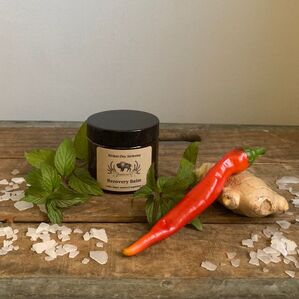- Home
-
All Products
- eGift Card
- Sleep Balm
- CBD Sleep Balm
- Recovery Balm
- CBD Recovery Balm
- Immunity Balm
- Little Buffalo Balm
- Simply Balm
- Heart & Soul Duo
- Magnesium Salt Soaks (1.85 oz)
- Magnesium Salt Soak (8 oz)
- Magnesium Salt Soak Bundle
- Self Care Candle Gift Set: Calming
- Self Care Candle Gift Set: Soul Warming
- Sleepy Buffalo Gift Set (2-Pack)
- The Gift of Wellness Set (3-Pack)
- The Gift of Wellness Set (2-Pack)
- Craft Your Own Gift Set (3-Pack)
- ADD ON: Extra Burlap Gift Bag
- Find in Store & Events
- Testimonials
- Contact
- Buffalo Beauts Partnership
- Blog
 When we go to our farmer’s markets and events, people tell us a lot about the health issues they’re experiencing. And one thing that stands out to us is how many people are in pain. There are sports injuries. Work injuries. Neck and back pain from a physically intensive job or from sitting at a computer all day. Headaches and migraines. Muscle cramps or PMS cramps. Arthritis. Bursitis. And a host of autoimmune-related conditions (fibromyalgia, rheumatoid arthritis, etc.) that are becoming more common all the time. And while magnesium cannot completely solve these conditions, there is often quite a bit it can do to help! After all, what these conditions have in common is inflammation. There are a few main things to know about how magnesium works in the body to ease pain and inflammation: According to Dr. Mark Sircus' book Transdermal Magnesium Therapy (2011), Dr. Jeff Schutt claims that “contraction and relaxation are dependent on adequate cellular levels of magnesium” (p. 216). In other words, transdermal magnesium can be used topically on muscles and tendons in order to allow them to contract and relax normally without injury. Our customers have even told us that they use our Recovery Balm not only after a workout but also BEFORE, to prevent so much inflammation from happening in the first place! Going one step further and utilizing massage with magnesium “increases flexibility and muscle tone and therefore reduces the risk of injury. Other benefits are: breakdown of scar tissue after injury, improved blood circulation and oxygenation, and providing general relaxation and reduced stress” (Sircus, 2011, p. 217). In fact, several massage therapists and chiropractors in the area even offer our magnesium balms to their patients! Of course, Dr. Sircus is clear that this is also true for non-athletes experiencing injuries or pain (such as back pain), and that applying transdermal magnesium or taking a warm bath in magnesium salts can help to alleviate inflammation in the body. (Of course, it is always important to discuss pain with a doctor before deciding whether to apply heat or cold to an injury.) In fact, any kind of muscle cramping or spasming is likely to be helped by transdermal magnesium, including leg cramps and PMS cramps! For leg cramps, apply magnesium to the calf muscles before bed, and for PMS cramps, apply magnesium to the abdomen and cover with a washcloth and heating pad to help with absorption. Regular use of magnesium throughout the month may also help with PMS symptoms. Magnesium deficiency has long been linked to migraines and headaches, of course - as you may already know, migraines were our motivation to start making magnesium balm several years ago! We often use our magnesium balm on our temples, neck, and shoulders to not only relieve a migraine that’s starting but also on a regular basis to keep inflammation down. (Side note: we have found that using magnesium glycinate along with our magnesium chloride-based balms is a great combination for migraines!) And, finally, Dr. Sircus (and several of our customers) have even linked transdermal magnesium to an easing of the pain associated with fibromyalgia, rheumatoid arthritis, and neuropathy. If you are looking for pain relief, our Recovery Balm is the most effective of our magnesium balms as it contains wintergreen, peppermint and ginger oils as well as cayenne extract to create a warming and cooling effect and boost circulation while easing inflammation. However, if you prefer other essential oils (or none at all), all of our magnesium balms have anti-inflammatory properties as well. Recovery Balm can be applied anywhere you have pain, while keeping in mind that a little goes a long way and you want to be sure to keep it away from your eyes or any sensitive skin! We also offer our Recovery Salt Soaks (with just peppermint and ginger) if you prefer a warm bath or foot soak to reduce pain and inflammation.
0 Comments
Your comment will be posted after it is approved.
Leave a Reply. |
AuthorsNikki Bradshaw Archives
February 2022
Categories
All
|
- Home
-
All Products
- eGift Card
- Sleep Balm
- CBD Sleep Balm
- Recovery Balm
- CBD Recovery Balm
- Immunity Balm
- Little Buffalo Balm
- Simply Balm
- Heart & Soul Duo
- Magnesium Salt Soaks (1.85 oz)
- Magnesium Salt Soak (8 oz)
- Magnesium Salt Soak Bundle
- Self Care Candle Gift Set: Calming
- Self Care Candle Gift Set: Soul Warming
- Sleepy Buffalo Gift Set (2-Pack)
- The Gift of Wellness Set (3-Pack)
- The Gift of Wellness Set (2-Pack)
- Craft Your Own Gift Set (3-Pack)
- ADD ON: Extra Burlap Gift Bag
- Find in Store & Events
- Testimonials
- Contact
- Buffalo Beauts Partnership
- Blog



 RSS Feed
RSS Feed